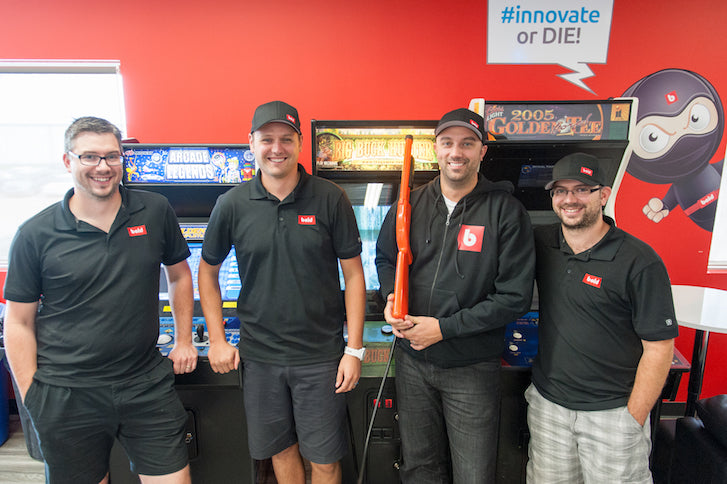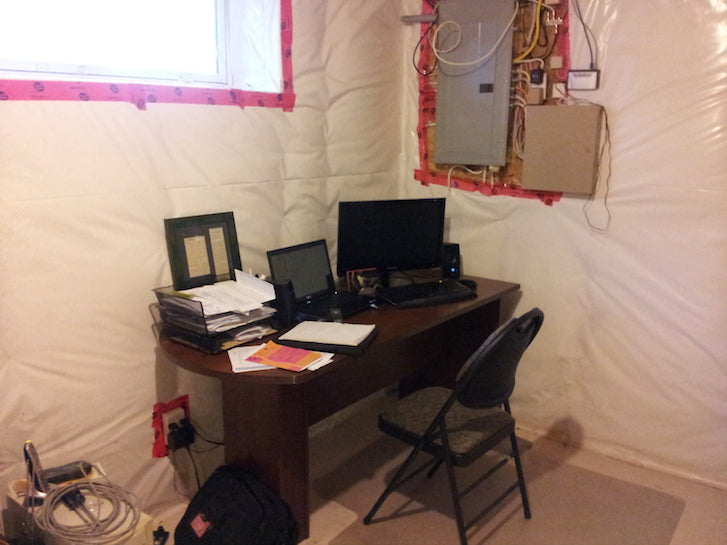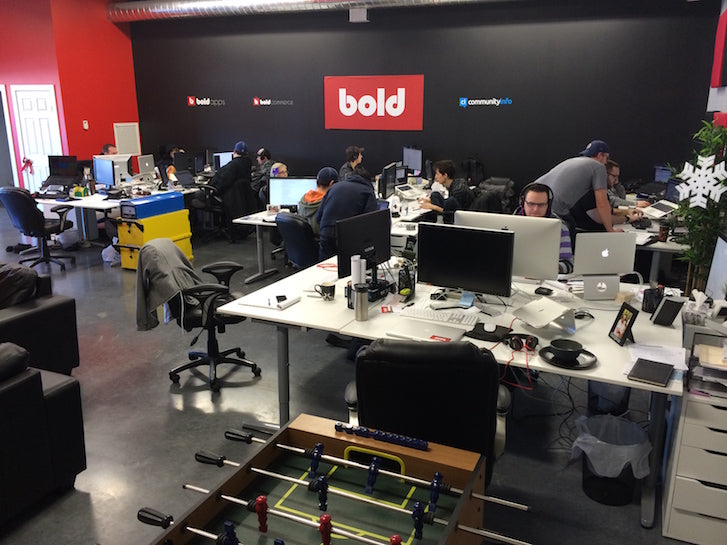“I believe that the money is in making the tools. They say during the gold rush, the people that made the most money were the ones selling the shovels.”
Jay Myers, co-founder of Winnipeg-based app development company Bold Commerce, told me this in February 2014. He had just hired their 15th employee — not bad for a company that started with four guys working nights in a basement, building an app for a platform they took a gamble on.
Today, they’ve hired more than 80 employees, and have diversified their service offerings to include custom apps, store builds, a webmaster service, among a few other things. But how did they get there? What mistakes did they learn from along the way? And what can we learn from them about how to launch a freelance business, quit your day job, and scale a company from one to many?
Jay shared his thoughts in an in-depth interview for a three-part blog series about Bold’s beginnings, growth, and the future. This is how they did it.
Bonus: Read to the end for six tips from Jay about how to launch and grow a freelance web design or development business of your own. In a rush? Skip ahead to Jay's tips.
Let's start at the very beginning
Jay has been selling online since 1999, back in the days when everyone was scrambling to eBay. The business? Heartland Archery, his family’s company in Winnipeg that sold archery products.
On eBay’s online marketplace, Jay realized that while he was getting sales, he wasn’t really building a brand. He was "renting customers."
“No one knew who we were,” he said. “They were just buying the item with the lowest price.” In the end, there was no value to the business he was creating. Essentially, it was only worth as much as the last product he listed.
To fix that, he decided to create an online store in 2005.

While seeing some level of success, and iterating on the design multiple times, he finally closed down shop in 2010. Margins were too low, and dropshipping wasn’t a thing in the archery world back then, so he was paying to ship products to Canada and then back to the states (where most of his customers lived).
The next step was joining a software company as an SEO specialist.
“In those days, SEO was not something you took in university. You just figured it out,” he said. He taught himself organically from his years running the family’s online store. And although he shelved the archery business, he never gave up the idea of running an online store.
A month after he was hired at the software firm, he was at it again, launching another online store (www.supremearchery.com — he doesn’t own it anymore). Jay got an email from his email marketing tool announcing their new Shopify app. That was the first time he heard of Shopify. He liked the idea of a web-based ecommerce tool with its own App Store, and he went to visit. Jay searched for a product comparison app — one that would compare products based on features like size, colour, and weight — but couldn’t find one. He thought, “Maybe I could build one.” Of course, without a background in app development, he couldn’t find a way to get going, and gave up on the idea for the time being.
A month later, Jay found himself in a pub with one of his best friends, Stefan Maynard.
“I’ve got a really good idea,” Jay told Stef. It was a Friday night, and they were a few beers in, but after sharing the concept of building a Shopify app, Stef instantly got excited. The two men brainstormed until 2 AM. By the time they left for home, they had a list of about 10 apps they wanted to build.
“Stef had two friends who were brothers and also developers,” Jay recalled. “We thought, ‘Let’s give this a try. It’ll be beer money on the side.’”
They brought Eric and Yvan Boisjoli on board, who would complete the founders’ foursome that would later become Bold Apps.

You might also like: 7 Secrets for Balancing Freelance Projects With Your 9 to 5
The first app
So what app would they start with? Traditionally, those in the Shopify App Store were geared toward storeowners — back-end tools like shipping integrations that made things easier for the merchant. But what about a tool that would be used on the front-end of a store?
“I came at it 100% thinking like a store owner,” Jay said. “What would make people more likely to buy, and therefore make me more money as a merchant?”
Their first product idea was a simple product upsell app. They called it… Product Upsell. The owner of the app store, Blair Beckwith, told them he’d never seen an app like it for Shopify; that it was the best kind of "hack" on Shopify’s API he'd seen.
Each of the four co-founders were still working their 9-5 jobs when the app first went live. Within the first week, Jay says he knew it would turn into a full-time job for them all someday — even when their very first customer left a negative review.
“I remember the exact store, and the guy’s name,” Jay said. “We launched on April 18, 2012. He installed the app, and within five minutes, he left us our first negative review.”
It was hard not to be disheartened, but it turned out to be an easy fix. They’d forgotten to upload one of the app’s instruction pages, so the merchant had no idea how to use the app. Oops.
“Their review turned out to be the best thing that ever happened to us,” Jay said. “It woke us up. These were real stores, owned by real people, making real sales. If our app doesn’t work, they’re screwed.”
This lesson served as the solidification of their motto to always provide excellent customer service and products that would help merchants succeed.
You might also like: How to Build Your First Shopify App
Quitting their day jobs
Jay always knew he would be an entrepreneur.
“For me, it’s in my blood,” he said. “At Thanksgiving dinners, we often reflect about how every single person around the table owns a business. My wife owns a dance studio; my sister owns a fitness company; my uncle owns a furniture business; my father owns a retail store; my mother has music studio.”
But quitting a stable job for an experimental venture was a risk, especially since the co-founders were starting families. The wives of the four men behind Bold had very specific requirements in order for their husbands to quit their jobs: You can do it, as long as you don’t take a pay cut.
The co-founders went from Eric's basement, to Stef's, and finally ended up working from the unfinished basement of Jay’s newly purchased house, trying not to wake his five-month pregnant wife who slept upstairs.



With the early success of the Product Upsell app, it was time to choose their next project — a product discount app. What did they name it? Product Discount, of course.
Eric was the first to quit his job. As one of the developers, it made sense to have him on full-time. He had a newborn at home, and had previously been working from 11 PM to 3 or 4 AM, but in October of 2012 he quit his job to focus full-time on Bold Apps. Stef became full-time soon after in November. Yvan joined the team as of January 2013, and Jay followed suit in March of that year. But they didn’t stop there — by May, they’d hired two additional employees.
Within 10 months of moving into Jay’s basement, they relocated into their very first, true, office space (which they outgrew in three months, but that’s a story for later).

Building a gazelle
“As soon as we could afford to hire someone, we hired someone,” Jay said. “Our mindset has always been to put 100% back into the company.”
There are two ways to run a business, according to Jay. You can build a lifestyle business — the four co-founders could have continued running the ship, hiring the fewest people possible, and finding a way to maximize profits.
Or you can build a gazelle company, the technical definition of which is, “a high-growth company that is increasing its revenues by at least 20% annually for four years or more,” according to Investopedia.
Bold Apps decided to become a gazelle.
“You have to pick one — lifestyle or gazelle,” Jay said. “Otherwise you’re going to wonder whether to hire every time, and stumble over other decisions. If you decide early on what kind of business you want to be, it frames the decision. The answer, for us, is always yes.”
This business decision laid the groundwork for Bold’s rapid growth. But how did they decide who to hire, and from where, and when? How did they scale their company sustainably to hold on to their roots and culture? That’s up next, in part two of this series.
Before you go, here are some pieces of advice Jay has if you’re thinking of launching or growing a design and/or development business from the ground up.
Jay's advice for launching a design or dev business
- Pick a niche and focus on it. “We said no to so many people who asked, ‘Can you build my restaurant website?’ It wasn’t ecommerce, so we said no — we’re going to be the ecommerce development shop. That was our original niche. We've found that customers like to to go the ‘expert’ in a field. So we picked ecommerce as our field.”
- Define your ideal customer. “A lot of people think, ‘What services do we want to offer?’ instead of, ‘What services does my ideal customer need?’ If you’re targeting a small business owner working out of their home, make your pricing clear and offer prepackaged hours of work. Even down to the language you use — if you’re going after the smaller players, in your welcome email say something like, ‘Don’t worry, there’s no big contract for you to sign. Just give me the go ahead and I’ll start on your site tonight.’ This is the way they like to be talked to. For big enterprise clients, they definitely want to sign something first.”
- Take on projects you’ll be proud of. “I would encourage people to take on projects that you can blog and brag about, not just the ones you can make money online on — especially in the early days. Your first few projects will end up in your portfolio, and those projects will define the next projects you get, and the next. Take the projects that look cool and that people will talk about, not just the ones that make the most money.”
- Do projects that are fun. “I know it sounds silly, but when you’re having fun, you end up making a better product. We have a queue of apps to build, but we choose the ones that make us say, ‘Oh, that would be fun.’ Whenever that word comes up, we know it’ll be a good project.”
- Avoid any decisions that could make you say, “I wish I would have…” I like to weigh the pros and cons by thinking to myself, ‘Okay, in 20 years, would I look back and say, “I wish I would have done it”?’ If I stayed at my job as an SEO specialist, I definitely would have said that in the future. To me, this makes it crystal clear what I have to do. That’s my barometer for making decisions.”
- Don’t be afraid to say no to clients. “Some people will just say yes to everything, because they think it will open doors and lead to amazing opportunities. That may be true, but you only have so many resources. Make sure your yeses are focused and strategic based on your business goals. We have a fun saying we use: We don't mow grass for money. By that I mean, we could all go out and mow grass for money, but it doesn't grow the value of our company. Our measure is always: Does it grow the business? Not just make us money, but will it help us grow? If the answer is yes, then that’s our answer too.”
In Part II, Jay will walk us through the growing pains of going from a small freelance business to a thriving multiple-employee company that is always looking to hire. What are the pros and cons to developing a gazelle business, and what takeaways does he have for businesses of any size? Stay tuned...
Read more
- Determination and Devotion: How Two Entrepreneurs Changed the Ecommerce Industry in Mexico
- How Shopify Plus Partner Maestrooo Balances Building Themes and Apps, with Client Work
- How We Built a Global Empire from a Small Island in the Pacific Ocean
- 2 Guys. 6 Months. 7 Apps.
- Building Superpowered Merchants One Migration at a Time: How ICEE Social Found Success with Shopify
- From Debt to Dollar Bills: How One Sri Lankan Teen Transformed His Life With Freelancing
- Profitable Pivots: How Octane AI Shipped Innovative Products in Uncertain Times
- Developing Customer Centric Solutions: How Yoast scoped, built and launched their Shopify App
- How Verbal+Visual helped an international home decor brand get a 163% revenue boost
You might also like: Starting Your Own Web Design Company: How to Freelance, Find Clients, and Grow Your Business

